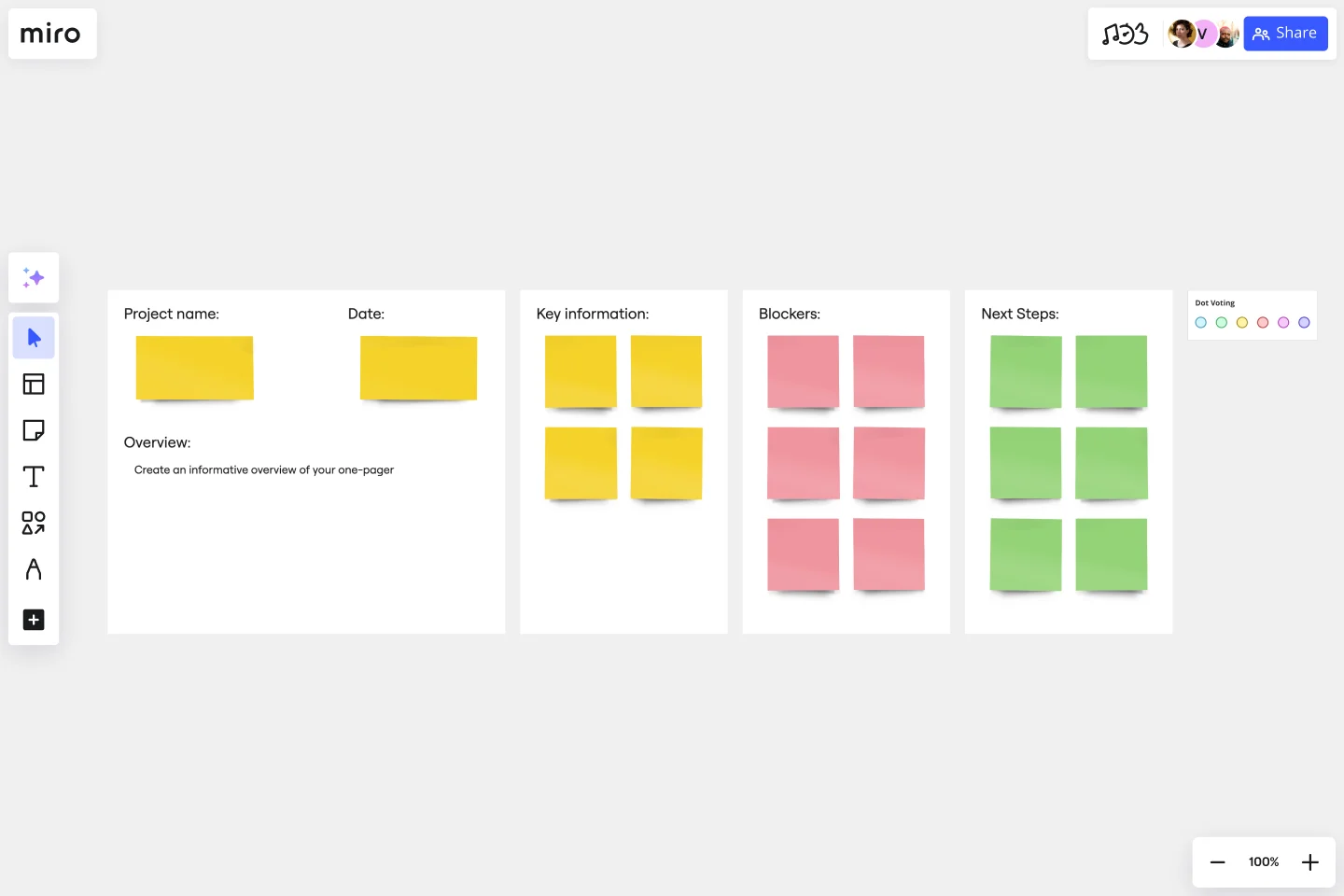One Pager Template
Communicate effectively with stakeholders with the one-pager template. Transform the way you lead projects and increase efficiency, aligning teams more quickly than ever.
About the One Pager Template
The one-pager template is a prime example of clarity and conciseness amidst the complexity of projects and data. It serves as a snapshot of ideas, plans, or projects in a compact format that is easy to comprehend. The document's main objective is to present essential information on a single page, ensuring everyone involved can quickly grasp the project's core objectives and stay aligned.
The one-pager template is an adaptable tool that encapsulates key elements of a project or topic into a concise, one-page document. The template typically includes:
Overview: This brief description offers a snapshot of the discussed project or subject.
Date: This refers to the relevant date or timeframe of the information presented. Summary
Key information: This section summarizes the most important data, insights, or outcomes.
Blockers: This section identifies any current or potential obstacles that could impede progress.
Next steps: This outlines immediate actions or future plans to continue the momentum.
Using these areas effectively allows people to quickly communicate essential aspects, providing a high-level understanding without overburdening with details.
How to use the one-pager template in Miro
To ensure a clear and concise one-pager, follow these steps:
Briefly summarize your project or idea in the Overview section.
Include the relevant date to provide context and anchor your one-pager in time.
Focus on the most critical information in the Summary area.
Identify any challenges or blockers to encourage proactive problem-solving.
In the Next Steps section, outline the immediate and future actions to guide your team.
Customizing the template is incredibly easy. Modifying the content to meet your specific requirements takes only a few clicks, just double-click sections and edit fields in the context menu bar. If necessary, you can effortlessly expand the template by adding new sections.
Why should you use a one-pager template?
Efficiency: It conveys critical information quickly without the need for lengthy explanations. Clarity: It provides a clear and concise format that highlights the most important aspects of a project. Alignment: It keeps everyone on the same page, literally and figuratively, reducing the risk of misunderstandings. Focus: It helps teams focus on key objectives, blockers, and next steps without getting lost. Versatility: It can be used for various purposes, from project summaries to proposal outlines, making it a go-to resource for many needs.
Can the one pager template be customized?
The template is designed to be flexible and can be customized to fit the specific needs of any project or initiative.
Is the one pager template suitable for all industries?
The adaptable template can serve various industries and departments, from marketing to product development.
How should I prioritize information on the one pager?
Prioritize information based on its importance to the project's objectives. Key information that directly impacts decision-making should be most prominent.
Can I share my one pager with external stakeholders?
The one pager is an excellent communication tool with external stakeholders. It's designed to be easily understood, even by those with limited background on the project.
Get started with this template right now.
Project Charter Template
Works best for:
Project Management, Documentation, Strategic Planning
Project managers rely on project charters as a source of truth for the details of a project. Project charters explain the core objectives, scope, team members and more involved in a project. For an organized project management, charters can be useful to align everyone around a shared understanding of the objectives, strategies and deliverables for a project of any scope. This template ensures that you document all aspects of a project so all stakeholders are informed and on the same page. Always know where your project is going, its purpose, and its scope.
Milestone Chart Template
Works best for:
Project Management, Strategic Planning, Project Planning
When your team is collaborating on a large project, keeping track of the many tasks and multiple timelines can be a challenge. That’s why you need a milestone chart. These visual representations of important project events will make it simple for your team to stay on schedule and reach goals on time. And it’s so easy to get started — just determine the major milestones, use our template to create a milestone chart, and define the key dates and deliverables each milestone will require.
RAID Log Template
Works best for:
Agile Methodology, Project Management, Agile Workflows
Use the RAID Log template to better understand potential risks, assumptions, issues, and dependencies relating to an upcoming project. With this information, you can make effective contingency plans and prepare your resources accordingly. You’ll know what could go wrong throughout the project and how to fix the problem.
Project Status Report Template
Works best for:
Project Management, Documentation, Project Planning
When a project is in motion, the project manager must keep clients and shareholders updated on the project’s progress. Rather than waste time with constant meetings, leaders can send out weekly or daily project status reports to keep everyone informed. You can use the Project Status Report Template to streamline the report creation and distribution process.
Visual Story Map Template
Works best for:
Marketing, Desk Research, Mapping
Some people like to think of a visual story map as a stylized to-do list, but it’s a lot more powerful than that. Visual story mapping allows your product management team to visualize multiple dimensions of information.
Fishbone Diagram by Dave Westgarth
Works best for:
Fishbone diagram
Identify and solve problems effectively with the Fishbone Diagram by Dave Westgarth. This template helps you break down complex issues into root causes, enabling a thorough analysis and targeted solutions. Use it for quality control, process improvement, and troubleshooting in various industries. Ideal for teams focused on continuous improvement and problem-solving.
